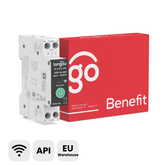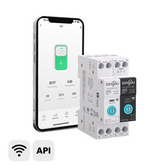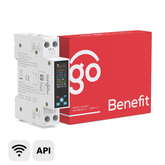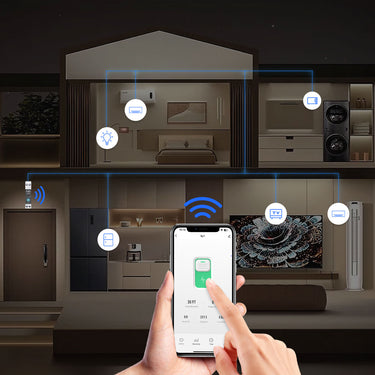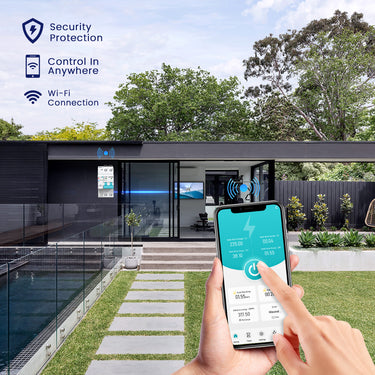What Is a Smart Circuit Breaker?Why to use them?

In the evolving landscape of electrical protection, smart circuit breakers represent the latest advancement aimed at improving safety, control, and efficiency in electrical systems. This post delves into the development history of circuit breakers, examines the key differences between traditional and smart circuit breakers, explains their working principles, and explores their applications, including the use of WiFi and Zigbee.
From Fuses to Smart Circuit Breakers:Fuse VS MCB VS Smart Breaker
Fuses: The Beginning
——Early Electrical Protection: Fuses were the first devices used to protect electrical circuits. They are simple devices that contain a metal wire or strip that melts when excessive current flows through, thereby interrupting the circuit.
——Limitations: Fuses need to be replaced after they blow, which can be inconvenient and costly.
Traditional Circuit Breakers
——Introduction: Circuit breakers were developed to overcome the limitations of fuses. Unlike fuses, they can be easily reset after tripping.
——Types: Various types of circuit breakers, including Miniature Circuit Breakers (MCBs) and Residual Current Devices (RCDs), brought advancements in protection against overcurrent, short circuits, and ground faults.
——Enhanced Safety: They offer enhanced safety features, such as thermal and magnetic tripping mechanisms.
Smart Circuit Breakers: The Latest Upgrade
——Evolution: The progression to smart circuit breakers integrates advanced technologies for improved functionality and convenience.
——Digital Transformation: Smart circuit breakers incorporate digital communication, allowing for real-time monitoring, control, and automation.
Differences Between Smart Circuit Breakers and Traditional Circuit Breakers
Functionality
1. Traditional Circuit Breakers:
——Basic Protection: Provide fundamental protection against overcurrent, short circuits, and ground faults.
——Manual Reset: Require manual resetting after tripping.
2. Smart Circuit Breakers:
——Advanced Protection: Offer enhanced protection features such as arc fault detection and surge protection.
——Remote Control: Enable remote monitoring, control, and resetting through internet-connected devices.
——Automation: Can integrate with smart home systems for automated responses based on real-time data.
Monitoring and Data
1. Traditional Circuit Breakers:
——Limited Data: Offer minimal data on circuit status, often limited to indicator lights or manual inspection.
——Basic Monitoring: Generally lack advanced monitoring capabilities.
2. Smart Circuit Breakers:
——Real-Time Data: Provide detailed real-time data on electrical parameters such as current, voltage, and power usage.
——Analytics and Alerts: Send alerts and notifications for abnormal conditions, aiding in proactive maintenance.
Integration and Connectivity
1. Traditional Circuit Breakers:
——Standalone Devices: Operate independently without connectivity to other systems.
——Manual Interface: Require physical access for operation and monitoring.
2. Smart Circuit Breakers:
——Networked Devices: Connect to home or building networks via WiFi, Zigbee, or other communication protocols.
——Smart Integration: Integrate with smart home systems, providing enhanced control and automation capabilities.
Working Principle of Smart Circuit Breakers
Core Components
1. Microcontroller: Acts as the brain of the smart circuit breaker, processing data and executing commands for protection and control.
2. Communication Module: Enables connectivity through WiFi, Zigbee, or other wireless protocols, facilitating remote monitoring and control.
3. Current and Voltage Sensors: Continuously monitor electrical parameters and feed data to the microcontroller for real-time analysis.
Operation
1. Data Acquisition: Sensors measure current, voltage, and other parameters continuously.
2. Analysis and Decision Making: The microcontroller analyzes data to detect faults, abnormal conditions, and patterns in power usage.
3. Trip Mechanism: When a fault or abnormal condition is detected, the microcontroller activates the trip mechanism to cut off the circuit.
4. Communication: Alerts and data are transmitted to connected devices,enabling remote monitoring and control through apps or web interfaces.
Energy Management
1. Consumption Monitoring: Smart circuit breakers track energy consumption, providing detailed reports to help users optimize electricity usage.
2. Load Management: Can prioritize and control different electrical loads to balance power consumption and reduce peak demand charges.
Functions of Smart Circuit Breakers
Key Features
1. Remote Monitoring and Control:
——Users can check the status of their electrical systems and control circuits remotely via smartphone or computer.
——Notifications and alerts are sent in real-time for immediate action.
2. Automation and Scheduling:
——Automated settings allow smart circuit breakers to operate on schedules, turning circuits on or off at pre-determined times.
——Scenario-based automation, such as shutting off non-essential circuits when not needed to save energy.
3. Fault Detection and Diagnostics:
——Advanced fault detection capabilities include identifying arc faults, ground faults, and predicting potential issues before they lead to failures.
——Diagnostic data helps in troubleshooting and maintenance, reducing downtime.
4. Integration with Other Smart Devices:
——Seamlessly integrates with other smart home or building management systems, improving overall efficiency and control.
——Enhances the capability of existing smart systems by providing energy management and enhanced safety features.
5. User Analytics:
——Provides users with detailed analytics on energy consumption and circuit performance.
——Helps identify inefficiencies and potential improvements in electrical usage.
Communication Protocols: WiFi and Zigbee
1. WiFi:
——Connectivity: Utilizes existing home or office WiFi networks to enable wide-ranging connectivity.
——Speed and Coverage: Suitable for high-speed data transfer and broad coverage within network range.
2. Zigbee:
——Mesh Networking: Uses a low-power, short-range mesh network that extends coverage through interconnected devices.
——Energy Efficiency: Designed for energy-efficient communication, making it ideal for devices requiring reliable and consistent connectivity over longer periods.
Application Scenarios
Residential Applications
1. Home Energy Management: Monitors and controls circuits in homes to optimize energy usage and enhance safety.
2. Smart Homes: Integrates with other smart home devices like thermostats, lighting, and security systems for improved automation and control.
Commercial Applications
1. Building Management Systems (BMS): Smart circuit breakers play a crucial role in managing energy consumption and ensuring the safety of commercial buildings.
2. Retail and Offices: Helps in load management and provides detailed energy usage reports to optimize expenses and enhance operational efficiency.
Industrial Applications
1. Factory Automation: Protects machinery and manages power distribution in manufacturing plants.
2. Data Centers: Ensures the reliability and efficiency of power supply systems, providing detailed analytics and alerts for proactive maintenance.
Tongou API Service

The api service is now available to help you better connect with our products!


